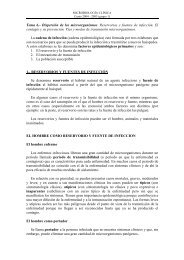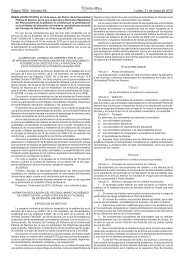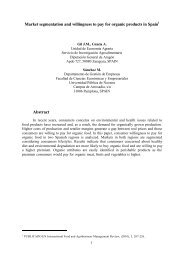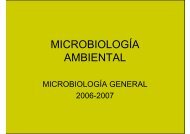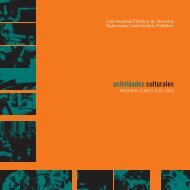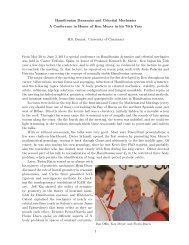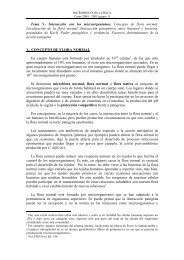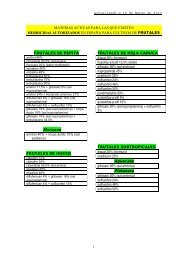Identification of Prosopis juliflora and Prosopis - Universidad Pública ...
Identification of Prosopis juliflora and Prosopis - Universidad Pública ...
Identification of Prosopis juliflora and Prosopis - Universidad Pública ...
You also want an ePaper? Increase the reach of your titles
YUMPU automatically turns print PDFs into web optimized ePapers that Google loves.
2species are sympatric in each centre. Studies using morphological characters(Solbrig et al. 1977), isoenzymes (Saidman 1985), seed protein electrophoresis(Burghardt <strong>and</strong> Palacios 1997) <strong>and</strong> molecular markers (Ramírez et al. 1999)have shown the occurrence <strong>of</strong> intra- as well as inter-series hybrids in populations<strong>of</strong> both sections Algarobia <strong>and</strong> Strombocarpa. These studies, however,support the division <strong>of</strong> the genus into sections. Pasiecznik et al. (2001) havesuggested the grouping <strong>of</strong> species <strong>of</strong> section Algarobia into ‘complexes’ or‘species groups’ principally according to their genetic similarity <strong>and</strong> geographicdistribution, but also to their habit <strong>and</strong> resource characters.<strong>Prosopis</strong> <strong>juliflora</strong> Swartz DC. <strong>and</strong> <strong>Prosopis</strong> pallida (Humbolt & Bonpl<strong>and</strong> exWilld.) H.B.K. were grouped into the ‘P. <strong>juliflora</strong>–pallida complex’ by Pasieczniket al. (2001), a suggestion also made earlier by Felker (1990). These twospecies occur over a broad geographical area approximately limited by thetropics <strong>of</strong> Cancer <strong>and</strong> Capricorn, including Mexico, Guatemala, El Salvador,Honduras, Nicaragua, Costa Rica, Panama, Colombia, Venezuela, Ecuador,Peru <strong>and</strong> the Caribbean isl<strong>and</strong>s. The species <strong>of</strong> section Algarobia to the northare P. gl<strong>and</strong>ulosa Torrey, P. laevigata (Humbolt & Bonpl<strong>and</strong> ex Willd.) M.C.Johnston <strong>and</strong> P. velutina Wooton, which may be considered a North Americancomplex. To the south <strong>of</strong> the P. <strong>juliflora</strong>–pallida complex lie all other species <strong>of</strong>section Algarobia, including P. chilensis (Molina) Stuntz emend. Burkart.The P. <strong>juliflora</strong>–pallida complex was divided into three geographically distinctgroups, termed ‘races’ by Pasiecznik et al. (2001). Group 1 comprisespopulations in Ecuador <strong>and</strong> Peru. P. pallida has been identified throughout thisarea while three varieties <strong>of</strong> P. <strong>juliflora</strong> have been identified in northern Peru<strong>and</strong> southern Ecuador (Burkart 1976). Burkart (1976) also reported a possibleP. <strong>juliflora</strong> · P. pallida hybrid in Ecuador. Populations in the north <strong>of</strong> this areadisplay some phenotypic characteristics typical <strong>of</strong> P. <strong>juliflora</strong> while those in thecentre <strong>and</strong> south appear to be purely P. pallida. Group 2 comprises populations<strong>of</strong> P. <strong>juliflora</strong> in Colombia, Venezuela <strong>and</strong> the Caribbean isl<strong>and</strong>s. Severalauthorities have included the Caribbean in the native range, <strong>and</strong> if not nativethey became naturalised in prehistory (Timyan 1996). Group 3 also comprisespopulations <strong>of</strong> P. <strong>juliflora</strong>, in the Pacific coastal areas <strong>of</strong> Central America fromMexico to Panama, with some inl<strong>and</strong> extensions. In the north <strong>of</strong> this region,populations <strong>of</strong> P. <strong>juliflora</strong> are thought to overlap with P. gl<strong>and</strong>ulosa <strong>and</strong>P. laevigata (Pasiecznik et al. 2001). However, the status <strong>of</strong> P. <strong>juliflora</strong> inMexico is uncertain (Pasiecznik et al. 2001), although recent work usingmolecular markers is beginning to resolve some <strong>of</strong> the underlying geneticvariation found here (Jua´rez-Mun˜ oz et al. 2002).Many <strong>Prosopis</strong> species are valuable multipurpose biotic resources in theirnative range <strong>and</strong> where introduced, providing timber, firewood, livestock feed,human food, shade, shelter <strong>and</strong> soil improvement (Harris et al. 1998). Severalspecies, for example the sub-tropical P. chilensis, P. gl<strong>and</strong>ulosa <strong>and</strong> P. velutina,<strong>and</strong> more importantly, the tropical species, P. <strong>juliflora</strong> <strong>and</strong> P. pallida, have beenintroduced in the last 200 years <strong>and</strong> are now widespread in, for example,Brazil, Sahelian Africa, South Africa, Pakistan, India <strong>and</strong> Australia. However,






